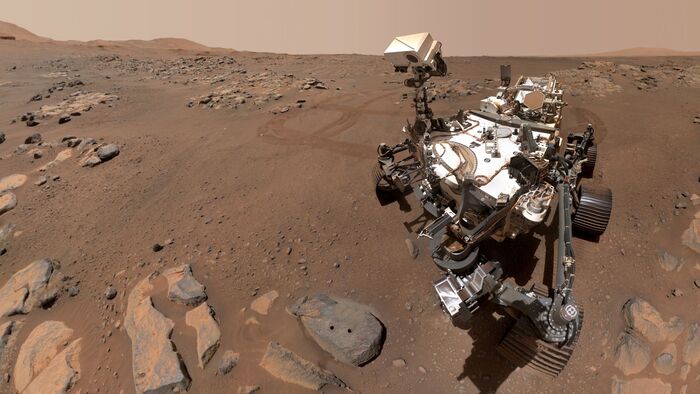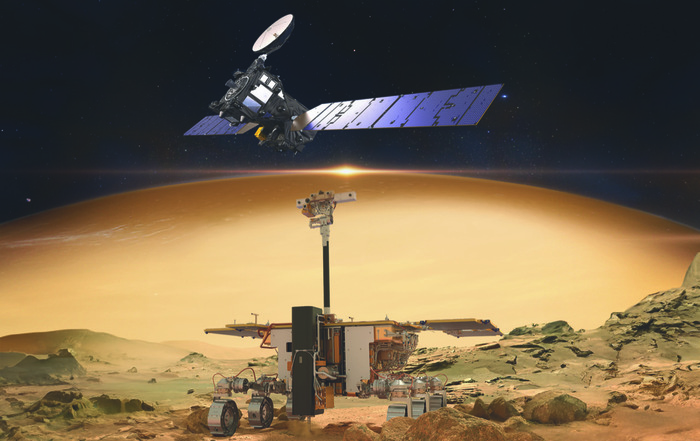It should go up to five meters deep into the soil of the Red Planet to explore where there might be enough warmth for the presence of liquid water - and possibly even for life. That was the plan anyway. But for months now, the "HP3" measuring device developed in Germany on the Nasa Marssonde "Insight" has worried the researchers involved.
"HP3" is a kind of nail that can hammer itself into the ground through technology in its interior. This so-called Martian mole had locked itself after thousands of blows in the soil of the plain Elysium Planitia north of the Martian equator in only 30 centimeters deep. After a long tinkering and a few technical conversions, he had recently penetrated a few inches further. But now it's over again.
The experiment is as bad as ever. Recent images of the US Space Agency show that "HP3" again half out of the hole hammered by him out. "No one could imagine that the mole would come out so fast," says Tilman Spohn from the German Aerospace Center, the responsible scientist, in an interview with SPIEGEL. One knows the observed phenomenon however of attempts on the soil, so Spohn.
"You can imagine it like a creme brulee"
At the moment, the researcher and his colleagues are working together to put it this way: Whenever the hammer mechanism in the gauge hits down, the whole apparatus also gets an impulse upwards. Finally, where a force is exerted, an equal opposing force is also effective - as it is called the so-called interaction principle, one of Newton's laws of mechanics.
You might also be interested in
Normally, the friction on the sides of the borehole should prevent "HP3" from moving upward due to the counterforce created. But that does not seem to work. At the same time loose material slips down from the edge into the drill hole - so when the hammer moves down again, the hole is suddenly less deep.
Spohn, he says, imagines the Martian soil as follows: The top ten centimeters are particularly hard, the researchers speak of a so-called Durikruste. Below that, however, the soil is obviously soft, like loose sand. "You can imagine it like a creme brulee". And that exactly makes "HP3" apparently a massive problem.
Other explanatory models, such as that in the ground hidden, frozen carbon dioxide had suddenly passed into the gaseous state and could have thrown the mole thereby up, Spohn considers much less plausible.
"That has a good chance of success"
Nevertheless, the researcher does not want to give up hope. It will take about two weeks to develop a new strategy. One idea is to turn the gripping arm of the "Insight" probe aside. He had helped in the previous rescue attempts of the Marsmaulwurf by first applying pressure to the ground in the vicinity of the borehole and later on the device itself. Thus, the friction in the ground could be increased slightly.
You might also be interested in
After a look into the borehole, the gripper arm should take over this task again. "This has a good chance of success," says Spohn. The researcher hopes that the focus of the mole is still within the hole and that the device is not too crooked. Then the tricky situation can possibly still get under control.
Next Mars missions are scheduled to launch next year
But it is also clear that any failed attempt restricts the further rescue options - also because the technical equipment is burdened much more than originally planned.
The "Insight" probe landed successfully on Mars in November last year. On board, she has next to the Mars mole and an earthquake warden, which is operated under the leadership of French scientists. With their help, several smaller Marsquakes have been detected. The research robot can not change its location in contrast to the "Curiosity" -Rover.
The next remotely controlled cars to launch "Mars 2020" from NASA and "Rosalind Franklin" from the European-Russian "Exomars" mission next year. Whether the latter probe but can lift off as planned, is not clear after two failed parachute tests this year.





